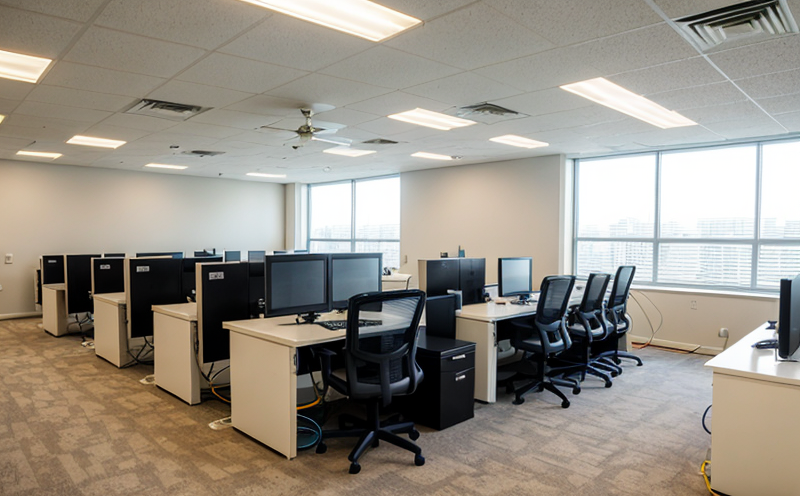EN 12464 Energy Efficiency Testing of Indoor Workplace Lighting
The European Standard EN 12464 provides a framework to measure and assess the energy efficiency of indoor workplace lighting systems. This standard is crucial for organizations aiming to comply with regulatory requirements, enhance sustainability efforts, and improve overall operational costs.
EN 12464 focuses on evaluating the light output (measured in lumens per watt), which directly impacts the energy consumption of a given lighting system. The test parameters include luminous flux measurement, electrical power input, and power factor evaluation. Specimens are typically representative samples of the lighting fixtures or systems to be tested.
The standard also addresses the operational conditions under which the testing is conducted, ensuring that results reflect real-world use scenarios. This includes temperature, humidity, altitude, and ambient light levels. Proper specimen preparation involves cleaning the lamp surfaces, ensuring they are in their normal operating condition before testing begins.
Instrumentation used for these tests typically comprises photometers to measure luminous flux, wattmeters to determine electrical power input, and data loggers to capture environmental conditions during the test period. The accuracy of these instruments is paramount to ensure reliable results.
Acceptance criteria are stringent and involve meeting specified limits on lumens per watt for different types of lighting fixtures. Compliance with these standards not only ensures that products perform efficiently but also supports broader sustainability goals by reducing unnecessary energy consumption in commercial and industrial settings.
The process involves multiple stages: initial setup, calibration of instruments, specimen preparation, conducting the tests under controlled conditions, recording data, and finally analyzing results to determine compliance with EN 12464 requirements. This detailed approach ensures that any discrepancies or non-compliance issues are identified early in the testing cycle.
By adhering to these standards, organizations can demonstrate their commitment to sustainability while also benefiting from potential cost savings on energy bills. Additionally, meeting such stringent criteria enhances a company’s reputation within its industry and among stakeholders who prioritize environmental responsibility.
- Competitive Advantage: Compliance with EN 12464 can set your organization apart in the market by showcasing leadership in sustainability practices.
- Market Impact: Meeting these standards helps reduce overall energy consumption, contributing positively to global environmental efforts.
- Innovation: The standard encourages continuous improvement in lighting technologies and designs.
- Regulatory Compliance: Ensures adherence to legal requirements imposed by various jurisdictions around the world.
Why It Matters
The importance of energy efficiency cannot be overstated in today’s world where sustainability and cost management are key priorities. Indoor workplace lighting consumes a significant portion of total electricity usage, making it essential to optimize its performance for both environmental and economic reasons.
Meeting the stringent requirements outlined in EN 12464 helps organizations achieve their energy efficiency goals by ensuring that new products or existing systems operate at optimal levels. This not only reduces operational costs but also contributes to reducing greenhouse gas emissions associated with electricity generation from fossil fuels.
Moreover, compliance with this standard provides a benchmark for evaluating the effectiveness of lighting improvements over time. It allows companies to track progress towards their sustainability targets and make informed decisions about future investments in more efficient technologies.
Benefits
The benefits of adhering to EN 12464 extend beyond mere compliance; they offer tangible advantages that contribute significantly to an organization’s success:
- Cost Savings: By reducing energy consumption, organizations can realize substantial savings on utility bills.
- Sustainability: Implementing efficient lighting solutions aligns with broader environmental goals and helps mitigate climate change impacts.
- Reputation Enhancement: Demonstrating commitment to sustainability enhances brand image and builds trust among customers, employees, and stakeholders.
- Innovation Opportunities: The standard encourages the development of innovative lighting technologies that go beyond basic functionality.
Competitive Advantage and Market Impact
The implementation of EN 12464 presents a unique opportunity for organizations to establish themselves as leaders in the field of sustainable lighting practices. Here’s how compliance can drive competitive advantage:
- Differentiation: Meeting these stringent standards sets your company apart from competitors who may not prioritize sustainability.
- Customer Preference: Increasing numbers of consumers and businesses favor suppliers committed to environmental responsibility.
- Premium Pricing: Products meeting this standard can command higher prices due to their perceived value.
- Regulatory Support: Many governments offer incentives for companies that adopt energy-efficient practices, providing additional benefits such as tax breaks or subsidies.





